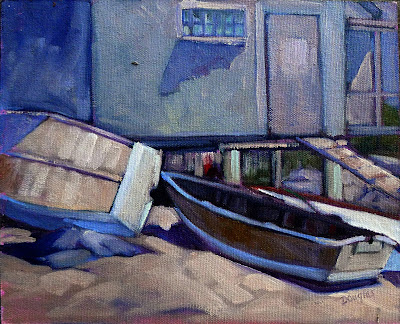There is always something to see, even when we’re stuck at home.
 |
| The tree outside my front door is a maple, and it’s bereft of leaves right now. |
Sue Colgan-Borror has been encouraging her fellow Knox County Art Society painters to take up a new art challenge each week. Last week’s subject was, “Where would you rather be,” to which Mary Ann Heinzen-Hackett responded, “Right here!” and went out and painted in the bitter cold. I’m with Mary Ann. Although I enjoy jetting off to exotic places to paint, I love my own home the best.
One of the issues we face in lockdown is that many of us are being deprived of meaningful contact with nature. This is not a mere luxury. Research has shown that people who regularly spend time in green spaces are physically and mentally healthier than their peers. This finding cuts across lines of race, economics and gender.
A few weeks ago, I had my weekly painting classpaint the view from their windows. This was a limited exercise, in that each of them was working from their studio space. That meant they had one, or possibly two, windows to work from. But what about the views from all the other windows, the ones we barely notice?
 |
| The tree on the dooryard is an Eastern White Pine. |
There are windows in my house that I seldom look out. I simply pass by them. I’m not alone in that. “When I encouraged people on social media to take a photo of a tree outside their window, one man replied that he’d thought it sad that he had no tree to photograph, before peering out into the street and realising that there was one right outside,” wrote Isabel Hardman.
Some of these tiny views that I ignore are arresting vignettes. Take the view from my front door. This door is never used; everyone uses the kitchen door, which opens off an area still called the dooryard in Maine. That neglected front door has a lace curtain over it, allowing only filtered light to come through. Outside is a beautiful old maple, the last survivor of a long line that once ran along Route 1. But since I never look at it, it’s seldom in my consciousness.
 |
| Tiny watercolor thumbnails done outside my window in Waldoboro, ME in the dead of winter. |
There’s looking, and then there’s looking. There’s a difference between glancing at a tree and spending time drawing or painting it. The latter will give you most of the health benefits of a trek through Acadia National Park, and you won’t have to break quarantine to do it.
The tree outside your window is just one example of the beauty to be found in the everyday. There is always something to see, even as our viewpoint narrows with circumstances. Édouard Manet died tragically young of syphilis; he suffered from pain and paralysis during the last three years of his life. Yet during this time he completed many small still lives of flowers, fruit and vegetables that are today among the most admired and beloved of his work. I’ll bet they brought him joy, too.
 |
| Most of these thumbnails were done from my window in Rochester, NY. |
A big part of learning to paint is learning to see. Your assignment this week is to travel around your house and make small thumbnail sketches from various windows. If you’re lucky enough to get outside, sketch what you see out there as well. All the examples I’ve included in this blog were done in my daily travels around town or from my own home. They’re in watercolor, but you can work in pencil or marker.
| A marker sketch of my current house. Your window sketches don’t need to be any more complicated than this. |
The goal here is two-fold:
- To see beauty in the everyday;
- To learn how to draw or paint better thumbnail sketches.



